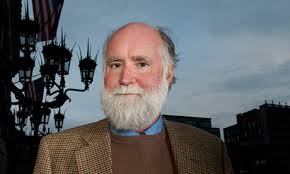
A Survey of Writers on Contemporary Writers
Listening to writers read and discuss their work at Newtonville Books, the bookstore my wife and I own outside Boston, I began to wonder which living, contemporary writers held the most influence over their work. This survey is not meant to be comprehensive, but is the result of my posing the question to as many writers as I could ask.
NICHOLSON BAKER

© Rick Friedman
RYAN MCILVAIN: Nicholson Baker is white-bearded and pudgy, Melvillean in his poetry and non-narrative meandering and occasional cantankerousness, and in his New England digs. Over the years he has amassed a decent half-shelf of slim, wild books, none slimmer or wilder than Vox, an erotic starburst of a novel. The book’s claims to extra-textual fame include Stephen King’s referring to it slightingly and, for Baker, productively (see his essay on the subject), as “a meaningless little fingernail paring,” and also Monica Lewinsky’s giving the book to President Clinton as a naughty token.
And it is a naughty book. One of the things I most love about Baker is his unflinching, matter-of-fact interest in sex. Baker doesn’t force his characters to settle for mere cuddling; he doesn’t coyly cut away from skin. He summersaults into the fraught fleshy territory that too many other contemporary writers tiptoe around. Vox narrates verbatim the conversation of a man and a woman who meet on a phone sex line. They talk about wetness and hardness and double penetration, and so on, and in the end they both get where they were going all along, but they also talk about their childhoods, favorite writing utensils, mail-order catalogues, the mysteries of pop music. At one point the unnamed woman in the conversation describes how she used to buy cassette tapes and “turn them up very loud—with the headphones on—and listen very closely, trying to catch that precise moment when the person in the recording studio had begun to turn the volume dial down, or whatever it was he did. Sometimes I’d turn the volume dial up at just the speed I thought he—I mean the ghostly hand of the record producer—was turning it down, so that the sound stayed on an even plane. I’d get in this sort of trance … where I thought if I kept turning it up—and this is a very powerful amplifier, mind you—the song would not stop, it would just continue indefinitely. And so what I had thought of before as just a kind of artistic sloppiness, this attempt to imply that oh yeah, we’re a bunch of endlessly creative folks who jam all night, and the bad old record producer finally has to turn down...
You have reached your article limit
Sign up for a digital subscription and continue reading all new issues, plus our entire archives, for just $1.50/month.
Already a subscriber? Sign in




